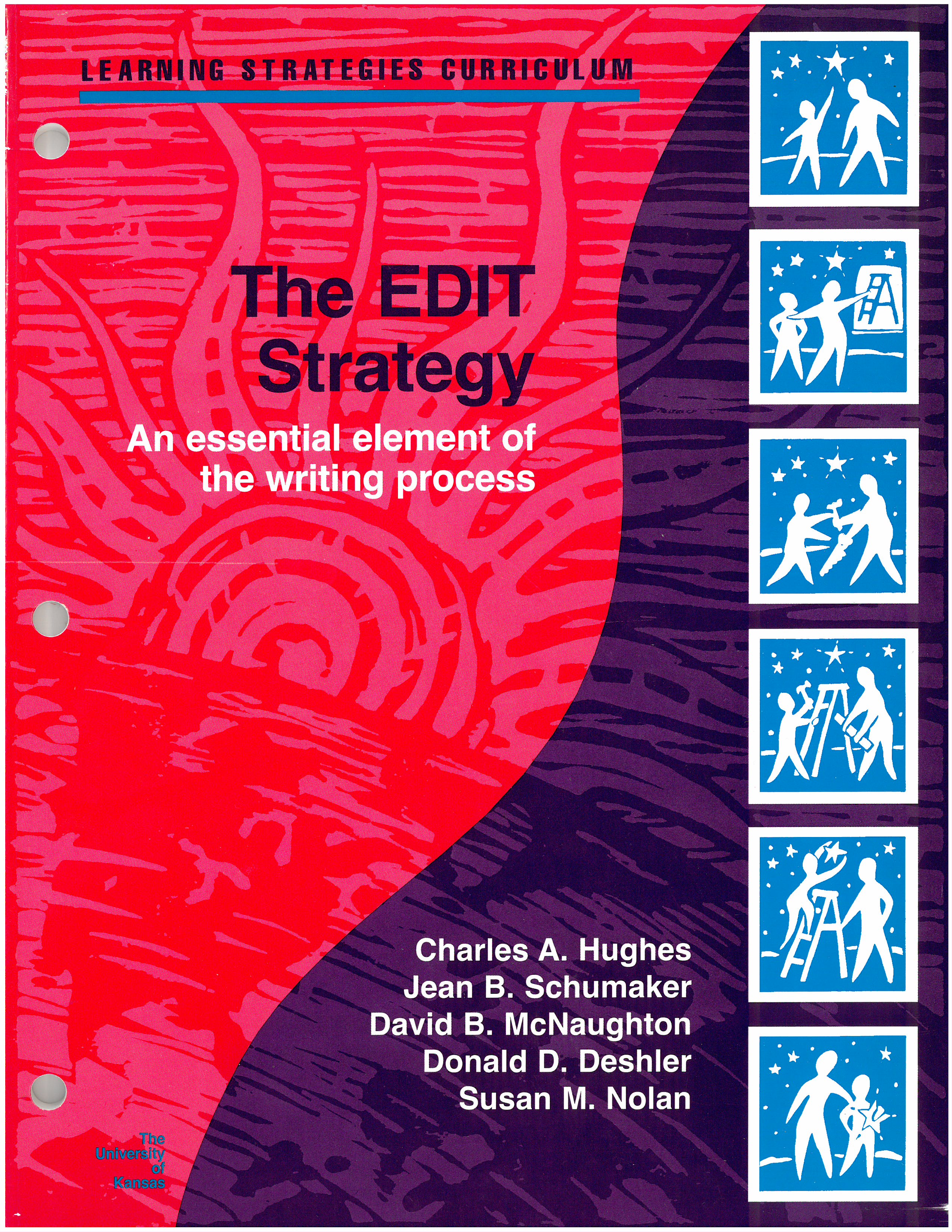The Edit Strategy

THE EDIT STRATEGY (recommended for GRADES 2+)
The EDIT Strategy enables students to find and correct errors on assignments created with a word processor. Students learn to enter their first draft into a word processing program, perform a spell check, run through the COPS Questions (which originate in the SIM Error Monitoring Strategy from 1982, and are related to capitalization, overall appearance, punctuation, and substance of the paper), and make the needed corrections.
In a randomized control study with 22 upper elementary and middle school students with learning disabilities, upon mastering the strategy, students were able to detect and correct 80 percent of the errors in a passage, compared to 28 percent of the errors before they learned the strategy. Students who did not learn the strategy had five times more errors in their written work than students who learned the strategy.
Author(s):Charles A. Hughes, Jean B. Schumaker, David B. McNaughton, Donald D. Deshler, and Susan M. Nolan
Publication and Purchasing Information: University of Kansas, Center for Research on Learning / KU CRL Online Store
Resources:
RESEARCH ARTICLES
- Woods-Groves, S., Hughes, C. A., Rodgers, D. B., Balint-Langel, K., Alqahtani, S. S., Neil, K. M., & Hinzman, M. (2020). Efficacy of a computer-based editing strategy with postsecondary students with intellectual and developmental disabilities. Education and training in autism and developmental disabilities, 55(2), 142-157. https://doi.org/10.1177/215416472005500203
- Hughes, C.A., Dexter, D.D., Kubo, M., & Dexter, C. (2017) The effectiveness of an editing strategy for upper elementary students with learning disabilities. Manuscript in Preparation.
- Woods-Groves, S., Hua, Y., Ford, J. W., & Neil, K. M. (2017). Efficacy of an electronic editing strategy with college students with intellectual and developmental disabilities. Education and Training in Autism and Developmental Disabilities, 2017, 52(4), 422– 436.
- Woods-Groves, S, Hua, Y, Therrien, W.J., Kaldenberg, E.R, Kihura, R.W., & Hendrickson, J.M. (2015). An Investigation of the Efficacy of an Editing Strategy with Post-secondary Students with Developmental Disabilities. Education and Training in Autism and Developmental Disabilities, 50(1), 95-108.
- Schumaker, J.B., & Deshler, D.D. (2009). Adolescents with learning disabilities: Are we selling them short? Learning Disabilities Research & Practice, 24(2), 81-92. - The authors review the evolution of SIM writing strategies and research that shows students with learning disabilities can learn and successfully use writing strategies under the right instructional conditions.
The Story Behind the EDIT Strategy from author Charlie Hughes:
Back in the late ‘80s, I attended a workshop where the presenter predicted that the computer-based word processor and accompanying spellchecker would ‘solve’ the spelling and other writing problems of students with LD. Unfortunately, while this technology has certainly helped many writers, it did not turn out to be the predicted panacea for struggling spellers and writers.
With regard to the use of spellcheckers by students with writing/spelling disabilities, our research showed improvement when they used spellcheckers; however, the students were still turning in products with multiple spelling errors. In fact, students were only detecting and correcting about half of their (many) spelling errors. This was due to two factors: (1) they were not effective users of the spellchecker, especially when there were many options provided or no options provided; and (2) the spellchecker was not detecting many of their errors (e.g., they were making homophone errors or using the wrong word in a correctly spelled form). With regard to other errors that word processors can detect, struggling writers often do not have a systematic way of dealing with them, nor do they understand what the errors are and how to change them.
We decided that struggling writers needed to be taught to be strategic users of word processor and spellchecker technology in order to benefit from their availability, and we were right. When students are taught the EDIT Strategy, their ability to detect and correct errors in their written work improved substantially.
Author's Thoughts about Strategic Instruction:
Based on my 25 years of work in the area of strategic instruction, I view this type of instruction as a key approach to the overall education of students with learning disabilities and other students who have difficulty learning. As a teacher, researcher, and parent, I have seen how much strategic instruction benefits students. Students not only learn these strategies and as a result perform better on school-related tasks, there is an overall benefit: they begin to see themselves as successful and competent learners. Another general benefit that I observe is that strategic instruction gives students a way of starting tasks and working their way through them. I often observed students just sitting at their desks looking at the writing assignment, test, or reading selection not knowing how or where to begin. Strategies are a concrete way of getting started and systematically solving problems and completing tasks. Not a small accomplishment!
Student and Teacher Feedback on the EDIT Strategy:
Most teachers we have trained to teach this strategy appear to like it. Their comments include “It works,” “Students like it,” “The products are easy to score,” and “The strategy is easy and quick to teach.” Some teachers have modified the practice activities to include other types of errors than those covered in the program. Such modifications are easy since the provided practice passages can be easily edited.
This product is available through the KU CRL Shop.
Please note that professional development, coaching, and infrastructure support are essential components to effective implementation of SIM instructional tools and interventions. It is highly recommended that you work with a SIM professional developer. See the SIM Event list for sessions or email simpd@ku.edu to learn more.
An accessible version of the documents on this site will be made available upon request. Please contact the KU CRL Professional Development Research Institute, at simpd@ku.edu to request the document be made available in an accessible format.